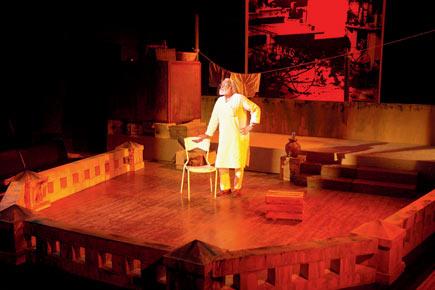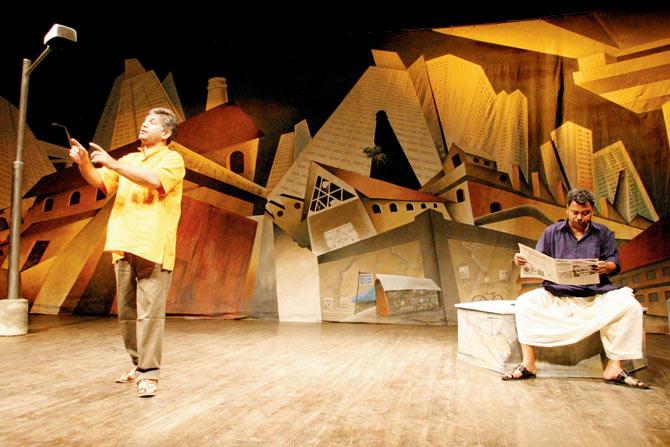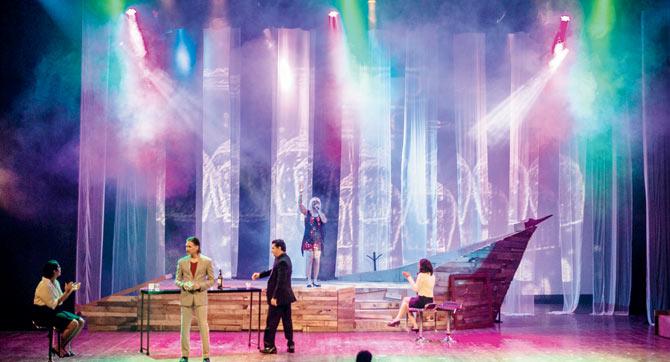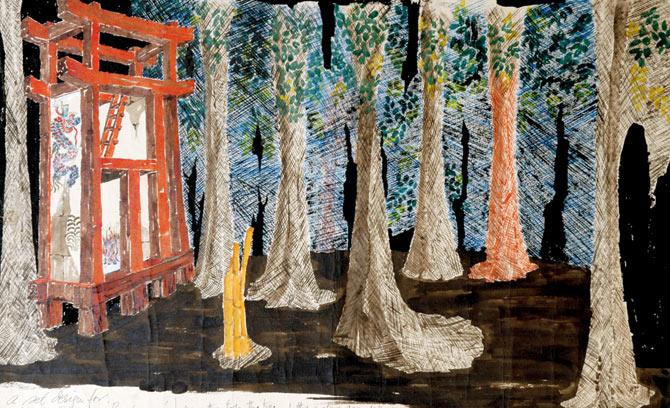From tight budgets to lack of skilled manpower, set design in Indian theatre is ridden with challenges. Ahead of his talk about the role of design in Indian theatre, icon MS Sathyu takes us backstage

From tight budgets to lack of skilled manpower, set design in Indian theatre is ridden with challenges. Ahead of his talk about the role of design in Indian theatre, icon MS Sathyu takes us backstage When we first met 84-year-old MS Sathyu, we couldn’t help but notice how his eyes lit up at the mention of the word 'design.' Dressed in a crisp white kurta-pyjama, the 60-plus years of experience sit lightly on his shoulders. The veteran, whose craft traverses films, theatre, ballet, small experimental and large-scale spectacular productions, shares his journey.
ADVERTISEMENT

(Above and below) Sketch Artwork and the final set designed by Vivek Jadhav for the play Cotton 56, Polyester 84, (February 2006) directed by Sunil Shanbag
Excerpts from the interview:
Biggest challenges in designing for theatre
There are certain constraints while designing for theatre, especially cost. Most groups can’t afford expensive sets. So you use the lowest budget and create the right ambience. Unlike film, venues change in theatre. When you design for Prithvi Theatre and the play moves to Tata Theatre, the dimensions change. It’s a creative job; you should know the story and the movement. You can’t read a story and design a set. You have to be a part of different aspects and then create a design or the décor. You need to attend rehearsals where you can tell the director how to use the set. In the West, sets are more elaborate; they manage to generate funds. The visual aspect is crucial. It’s necessary to create the right ambience. So while many plays are staged in Mumbai only a handful of designers exist. Material used in one set is reused in other play. Often, it becomes a make-do thing. In Mumbai, you get theatres just for four hours – you put up the set, light it and dismantle. Theatres like Bhaidas have back-to-back shows.

Designing for Film or theatre?
The grammar of cinema and the grammar of theatre are different. It is about how you adapt. So you have to know the grammar first. It happens to actors too. Many times, a stage actor when he does cinema, tends to be too dramatic, too loud, subtlety is gone. In cinema in a close up especially, you have to be very subtle as every movement of the muscle can be seen. That understanding and adaptability has to come. Unless you know the grammar you can’t speak that language. Designing for theatre does not pay but is very satisfying.

Learning the art
You can learn the craft and the technique in a design school to a certain extent but in practical execution a lot of it is different.You must know what kind of materials are available in the market. For example, thermacol was not available in the market before 1956. A company called Beardsell came up in Cadell Road who started selling thermacol. It was a German patent. Even in Europe it was available in Germany but not in France, for example. There is fibreglass and bubble sheets are things that were not there earlier and are available now. When they are new you must learn how to use them. What is architecture? It is learning to use new material and creating various shapes and sizes. It’s important to be clued in.

MS Sathyu giving instructions to the light operator, at Prithvi Theatre, on the sets of Sarphire — an IPTA Mumbai production. The play was directed by Rajendra Gupta and sets were designed by MS Sathyu
Modern-day design
Today, all sorts of gadgets are used on stage, multimedia projections. The scope is a lot. What you need to understand is whether or not the play needs that technology and if it betters the play. Sometimes, people start using it just because it is available. It’s a learning process. I used projection in my plays in 1958-59. I used a cinema projector, slide projector, using 35mm slides to project; there was no television and video those days. There was Kodak carousel projectors, which are obsolete now. I have slides but no projector. We have to scan them now and convert them to another format, to save them. I have used a projector in the plays Mudrarakshas and Akhri Shama, but I don’t enjoy it too much. It’s not my kind of thing. Earlier, when you used a projector, you had to control the lighting on the stage such that it did not spill to the screen. Then the projection becomes dark. That does not happen these days with pixels. Earlier, we used canvas, stretched in a frame. Some of the popular materials today include plywood to give it strength, fiberglass, different plastics and PVC.

Multimedia projection used for the set of Merchant of Venice, directed by Vickram Kapadia. Set designed by Fali Unwalla and Vickram Kapadia. Pic Courtesy/Neville Sukhia
Down the memory lane
There was a play directed by Janak Toprani written by Aurobindo, which is about two different states Magadh and Avantika. The entire set does’t change. There is just one flag in the middle, which turns to show you the state. Another interesting play that I did with Janak was Rashomon, which is a famous film by Akira Kurusawa. Throughout the film, there was a drizzle in the forest. The same story is told from the viewpoint of four characters. There is one spirit and the audience is the judge as to which version of the story is correct. This was a challenge. The film impacted me. I wanted to translate that feeling on stage. I used a lot of gauze and nets to create forests as well as appliqué trees and leaves. We used lighting to create the drizzle. It can also be created using a projector but hiring a projector for each show was very expensive.

Set design created by MS Sathyu for the play Rashomon
Theatre in Mumbai
Mumbai has more theatre than Delhi and other cities. Delhi's group theatre is dead. Everyday, you can chose from at least 20 different plays in Mumbai and in different languages including Gujarati, Hindi, Marathi, and English. Thus, quantity and quality are great in Mumbai.
Look out for
Recently, I designed Garindey the villains for IPTA. It is an elaborate set, with a grand staircase going into a balcony. It is set in 1920s America, where we’ve tried to recreate the country from those times, with sets and costumes.
I am working on the sets of Anarkali that I will do with NCPA in October. It is an lavish, expensive set. I have used miniatures, figure of dancers and courtiers. I still have to work on the flooring etc. In a lot of period plays, there are no references. You keep a particular era in mind and follow the style.
Talk by MS Sathyu
On: Today 5 pm
At: MCubed Library, Princess Bldg, Ground Floor, D'Monte Park Road, Next to Bandra Gymkhana, Bandra (W)
Log on to: www.junoontheatre.org
 Subscribe today by clicking the link and stay updated with the latest news!" Click here!
Subscribe today by clicking the link and stay updated with the latest news!" Click here!






